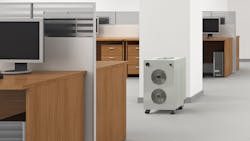Knorr Brake Company has released its Merak® 2-Stage Air Filtration and Purification System.
Testing from an independent ISO 17025 accredited laboratory found that the system’s technology eliminates 99.9 percent of airborne viruses, including COVID-19 and its variants, and bacteria within five minutes, depending on total room size.
The newly launched system is configured by Merak North America, a division of KBC, and is engineered for use in office spaces, buildings and facilities to defend against airborne viruses, bacteria and pollutants. The compact unit employs the same technologies as the company’s 3-Stage Air Filtration and Purification System, launched in June 2020 for use with rail transit HVAC systems.
“The unit delivers the perfect pairing for transit authorities and other operators,” said Jason Connell, Knorr Brake Company president and CEO. “While our powerful 3-Stage System helps protect riders on an authority’s transit vehicles, the 2-Stage System offers the same proven protection for the personnel who propel their business. Whether it’s in the offices, shops, cafeterias or any common space where employees and guests work or gather, our systems are always on guard.”
Connell continued, “As people return to the office amid changes in mask requirements and more, the need for increased air filtration and purification, like the 2-Stage System, is critical. Offering an indoor air solution as robust as the solution available for transit vehicles ensures peace of mind and ongoing protection for everyone.”
KBC’s compact 2-Stage System provides constant filtration and purification to clean the air in rooms and spaces, resulting in up to 12 air changes per hour. While the system does not negate the need for employees and guests to adhere to local, state and national health practices concerning face masks and PPE, it delivers air sanitization, helping to substantially reduce the risk of infection and transmission of airborne viruses and bacteria.
Laboratory testing showed the antimicrobial solution delivers the same level of protection against a broad array of live contaminants and pollutants, including H1N1 influenza, staph bacteria, black mold, natural bacteria, H3N2 influenza, total volatile organic compounds, cigarette odors, formaldehyde, toluene, acetaldehyde, small particulates and more.
The system works with the use of two interlocking, lab-tested and field-proven steps.
First, the Merak® Intense Field Dielectric filtration process provides an initial line of defense by actively filtering out large particles and electrostatically filtering out smaller particulates down to 23 nanometers in size.
Second, the Merak Dielectric Barrier Discharge technology uses bipolar ionization to purify the air, dispersing between 3.5 million to 5 million positive and negative oxygen ions per cubic centimeter to attack viruses, bacteria and pollutants. These pollutants and contaminants, including exhaust fumes, smoke and odors, are dissolved into water and carbon dioxide and removed.
Laboratory testing of the Merak 2-Stage System demonstrated it provides 99.99998 percent efficacy against aerosolized MS2 bacteriophage and up to 99.998 percent against E. coli. The small RNA virus is recognized by the U.S. Environmental Protection Agency as a representative virucidal screening tool for demonstrating efficacy against COVID-19. The MS2 virus is smaller than others, harder to capture and requires significantly more radiation to inactivate.
“Documented test results combined with ongoing testing definitively demonstrate that the Merak® 2-Stage Air Filtration and Purification System is effective not only against the continuing threat of the COVID-19 virus and its variants, but also against an array of other live viruses, pollutants, and even odors,” Connell said. “Neutralizing and removing these contaminants from indoor air is critical for the safe operation of facilities throughout the year. In deploying this system, facilities have the best air sanitation technology available in a portable and compact solution that’s easy to use and maintain.”
Three standard capacity-option models of the portable 2-Stage System are currently available to accommodate the needs of differently sized rooms and spaces. Facilities with specialized needs can also contact KBC to request an evaluation for a custom engineered unit.
The three standard models offer different air flow rates and capacities for various spaces and performance levels. The 1,800, 1,200 and 600-cubic feet per minute (CFM) air flow capacity models provide up to 12 air changes per hour for spaces up to 1,000-square feet, or two complete air exchanges per hour for a 6,000-square-foot room.
Multiple features built into each portable unit make the system especially useful and easy to incorporate into normal operations:
• An hour meter to monitor usage.
• Lightweight design with locking caster wheels for ease in moving and placement.
• Low noise and non-intrusive operation at approximately 54 decibels – similar to a quiet office or normal home ambient sound.
• Minimal operating costs and low power consumption – similar to a typical floor or box fan.
• Small footprint measuring approximately 18.5 inches wide by 31 inches tall by 12 inches deep.
The 2-Stage System is also easy to set up and maintain. To operate, simply plug the unit into any wall outlet and turn it on. The coated metal surface fits discreetly into building interiors as the unit works quietly to filter, purify and recirculate the air. Each unit is equipped with locking caster wheels for maximum portability and can be moved around as needed. The system can also be adapted to meet a facility’s needs, and multiple units can be located within spaces or facilities to optimize air distribution and treatment and maximize protection for occupants.
Maintenance for the system is also fast and easy, as the unit requires surface dusting and regular cleaning of its reusable filters. There is no need to replace the filters on each unit.
“The testing behind this portable system provides conclusive, scientifically backed data showing that its filtration and purification process works quickly and thoroughly to sanitize indoor air and protect against airborne transmission of viruses and bacteria,” Connell said. “This is the continuous level of protection that offices and facilities need as they reopen and return to full capacity.”



